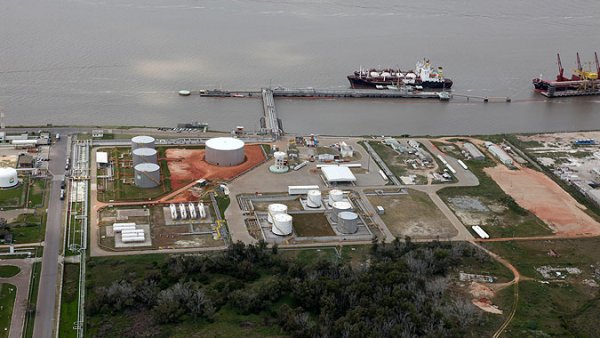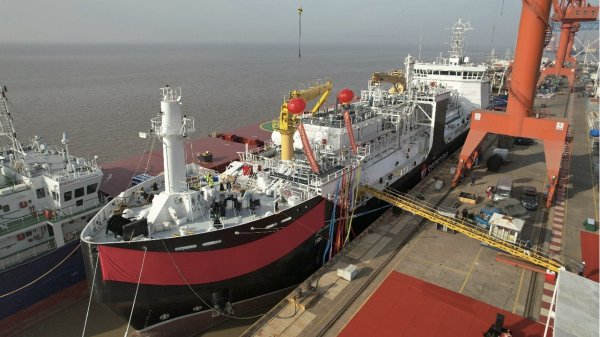Hose-in-hose LNG transfer system 'revolutionary', says Trelleborg
System is said to improve safety, lower costs and improve access to low-emission LNG fuel.
Trelleborg AB, a leading supplier of innovative flexible bonded hose solutions for the crude oil, chemicals and Liquefied Natural Gas (LNG) offshore industries, has highlighted the areas where its 'revolutionary' and 'game changing' Cryoline hose-in-hose transfer system for LNG will enable the extended use of environmentally friendly LNG fuel, optimize the safety of its transfer, and significantly lower operator and supplier costs.
According to Trelleborg, the cryogenic floating hose system enables rethinking of the conventional wisdom in LNG ship-to-shore transfer for regasification, liquefaction and terminal storage, as well as for gas power generation projects. It is also said to offer a more viable and innovative alternative to existing ship-to-ship transfer systems, ensuring higher safety and operability standards through optional increased distances between vessels. And in utilizing ariel hoses with large inner diameters ranging from 16 to 20 inches, operators have a greater choice of configuration, more flexibility, and a less strenuous replacement to conventional ship-to-ship systems, the Sweden-headquartered engineering group says.
Gianni Sicuro, global director for Trelleborg's fluid handling operation, said: "As a Group, we pride ourselves on being able to offer the most innovative and high quality products to ensure safety. We have achieved that again in re-thinking LNG transfer and challenging the status quo. Cryoline hose-in-hose transfer system (with its full extended range from 6 to 20 inches diameter) is truly a 'game changing' technology, which will contribute to making it easier and cheaper to transfer LNG. It fulfils our philosophy of providing our customers with feasible solutions that improve productivity levels, protect the environment, save valuable resources, and make a genuine difference to the bottom line for operators and suppliers.
"In today's challenging markets, optimizing operability is crucial. Trelleborg's cryogenic floating hose is the only solution that could potentially offer up to 80% in operating cost reductions compared with traditional transfer solutions, equating to significant savings."
Vincent Lagarrigue, head of product management for Trelleborg's fluid handling operation, added: "The Cryoline floating hose was more than seven years in development and validation, and is the first floating hose of its kind to receive the coveted EN1474-2 accreditation. Meeting the standard means that we are part of a transformation in the way that LNG can be handled. It will help make safer ship-to-ship transfer possible at a potentially lower cost, and in particular, in the small-scale LNG market, it can fulfill the operators' desire to open up new markets in remote areas and negate the needs for costly on-shore infrastructure. We expect this hose-in-hose transfer system to be truly revolutionary.
"The market has been looking for some time for an option to transfer LNG to remote locations. Indonesia, for example, has set a target of 100% electrification by 2019, with gas playing an important role in meeting this target. This hose-in-hose transfer system will make this possible as LNG can be transferred directly without the need for infrastructure such as jetties."
Key applications for the Cryoline hose-in-hose transfer system include:
Ship-to-shore configuration
The cryogenic floating hose system enables rethinking of the conventional wisdom in LNG ship-to-shore transfer. Unloading and loading of LNG presently relies on the construction and availability of complex infrastructure, such as a permanent jetty with breasting and mooring dolphins, fenders and loading arms. Trelleborg's Cryoline floating hose transfer solution enables direct connection from ship-to-shore, with installation in potentially just a few days, while ensuring the highest standards of safety. In negating the high cost of infrastructure captital expenditure, Trelleborg's latest transfer solution offers a cost-effective and flexible alternative to the present way of transferring LNG.
Ship-to-ship floating configuration (FSRU)
Cryoline hose-in-hose technology offers a more viable and innovative alternative to existing ship-to-ship transfer systems, ensuring higher safety and operability standards as the distance between the vessels can be increased in both ship-to-ship and tandem transfer. With Trelleborg's floating cryogenic hoses, vessels can be moored as much as 300 to 500 meters away from a storage unit, allowing for ship-to-ship transfer in deeper waters in even the most challenging conditions.
Ship-to-Ship aerial configuration
Cryoline hoses will be available with large inner diameters ranging from 16 to 20 inches. This will provide operators with a greater choice of configuration, more flexibility and a less strenuous replacement to conventional ship-to-ship systems. For example, in ship-to-ship aerial transfer, only three of Trelleborg's 16-inch Cryoline hoses need be used, instead of ten eight-inch hoses; reducing handling time by as much as 60%.
During the development of the Cryoline hose-in-hose technology, several full scale hose prototypes were successfully tested in both static and dynamic conditions at Trelleborg's research and development facilities for hoses in Clermont-Ferrand, France. Most of the tests took place in cryogenic conditions at -196 °C/ -321 °F and in these floating hoses were able to demonstrate their ability to withstand fatigue resistance in even the most hazardous conditions.
According to Trelleborg, the cryogenic floating hose system enables rethinking of the conventional wisdom in LNG ship-to-shore transfer for regasification, liquefaction and terminal storage, as well as for gas power generation projects. It is also said to offer a more viable and innovative alternative to existing ship-to-ship transfer systems, ensuring higher safety and operability standards through optional increased distances between vessels. And in utilizing ariel hoses with large inner diameters ranging from 16 to 20 inches, operators have a greater choice of configuration, more flexibility, and a less strenuous replacement to conventional ship-to-ship systems, the Sweden-headquartered engineering group says.
Gianni Sicuro, global director for Trelleborg's fluid handling operation, said: "As a Group, we pride ourselves on being able to offer the most innovative and high quality products to ensure safety. We have achieved that again in re-thinking LNG transfer and challenging the status quo. Cryoline hose-in-hose transfer system (with its full extended range from 6 to 20 inches diameter) is truly a 'game changing' technology, which will contribute to making it easier and cheaper to transfer LNG. It fulfils our philosophy of providing our customers with feasible solutions that improve productivity levels, protect the environment, save valuable resources, and make a genuine difference to the bottom line for operators and suppliers.
"In today's challenging markets, optimizing operability is crucial. Trelleborg's cryogenic floating hose is the only solution that could potentially offer up to 80% in operating cost reductions compared with traditional transfer solutions, equating to significant savings."
Vincent Lagarrigue, head of product management for Trelleborg's fluid handling operation, added: "The Cryoline floating hose was more than seven years in development and validation, and is the first floating hose of its kind to receive the coveted EN1474-2 accreditation. Meeting the standard means that we are part of a transformation in the way that LNG can be handled. It will help make safer ship-to-ship transfer possible at a potentially lower cost, and in particular, in the small-scale LNG market, it can fulfill the operators' desire to open up new markets in remote areas and negate the needs for costly on-shore infrastructure. We expect this hose-in-hose transfer system to be truly revolutionary.
"The market has been looking for some time for an option to transfer LNG to remote locations. Indonesia, for example, has set a target of 100% electrification by 2019, with gas playing an important role in meeting this target. This hose-in-hose transfer system will make this possible as LNG can be transferred directly without the need for infrastructure such as jetties."
Key applications for the Cryoline hose-in-hose transfer system include:
Ship-to-shore configuration
The cryogenic floating hose system enables rethinking of the conventional wisdom in LNG ship-to-shore transfer. Unloading and loading of LNG presently relies on the construction and availability of complex infrastructure, such as a permanent jetty with breasting and mooring dolphins, fenders and loading arms. Trelleborg's Cryoline floating hose transfer solution enables direct connection from ship-to-shore, with installation in potentially just a few days, while ensuring the highest standards of safety. In negating the high cost of infrastructure captital expenditure, Trelleborg's latest transfer solution offers a cost-effective and flexible alternative to the present way of transferring LNG.
Ship-to-ship floating configuration (FSRU)
Cryoline hose-in-hose technology offers a more viable and innovative alternative to existing ship-to-ship transfer systems, ensuring higher safety and operability standards as the distance between the vessels can be increased in both ship-to-ship and tandem transfer. With Trelleborg's floating cryogenic hoses, vessels can be moored as much as 300 to 500 meters away from a storage unit, allowing for ship-to-ship transfer in deeper waters in even the most challenging conditions.
Ship-to-Ship aerial configuration
Cryoline hoses will be available with large inner diameters ranging from 16 to 20 inches. This will provide operators with a greater choice of configuration, more flexibility and a less strenuous replacement to conventional ship-to-ship systems. For example, in ship-to-ship aerial transfer, only three of Trelleborg's 16-inch Cryoline hoses need be used, instead of ten eight-inch hoses; reducing handling time by as much as 60%.
During the development of the Cryoline hose-in-hose technology, several full scale hose prototypes were successfully tested in both static and dynamic conditions at Trelleborg's research and development facilities for hoses in Clermont-Ferrand, France. Most of the tests took place in cryogenic conditions at -196 °C/ -321 °F and in these floating hoses were able to demonstrate their ability to withstand fatigue resistance in even the most hazardous conditions.

|
IMO approves pricing mechanism based on GHG intensity thresholds
Charges to be levied on ships that do not meet yearly GHG fuel intensity reduction targets. |
|
|
|
||

|
VARO Energy expands renewable portfolio with Preem acquisition
All-cash transaction expected to complete in the latter half of 2025. |
|
|
|
||

|
NYK trials biofuel in milestone coal carrier test
Vessel is used to test biofuel for domestic utility company. |
|
|
|
||

|
H-Line Shipping orders LNG bunkering vessel
Vessel with 18,000-cbm capacity to run on both LNG and MDO. |
|
|
|
||

|
How to engineer and manage green shipping fuels | Stanley George, VPS
Effective management strategies and insights for evolving fuel use. |
|
|
|
||

|
Swedish government bans scrubber wastewater discharges
Discharges from open-loop scrubbers to be prohibited in Swedish waters from July 2025. |
|
|
|
||

|
MAN Energy Solutions achieves 100% load milestone for ammonia engine
Latest tests validate fuel injection system throughout the entire load curve. |
|
|
|
||

|
Petrobras secures ISCC EU RED certification for B24 biofuel blend at Rio Grande
Blend consisting of 24% FAME is said to have been rigorously tested to meet international standards. |
|
|
|
||

|
Stolt-Nielsen to fully control Avenir LNG with acquisition
Share purchase agreement to buy all shares from Golar LNG and Aequitas. |
|
|
|
||

|
Bureau Veritas supports launch of CIMC SOE's LNG bunkering vessel
Handover of Seaspan Energy's cutting-edge 7,600-cbm vessel completed. |
|
|
|
||
Related Links
- · Shell deploys third LNG-fuelled OSV in Gulf of Mexico [Insights]
- · LNG-conversion-ready tanker christened [Insights]
- · AIDAprima completes full LNG test run [Insights]
- · GTT signs LNG barge training programme [Insights]
- · Agreement to develop Alternative Energy Hub in Antwerp [Insights]
- · Sweden [Directory]

